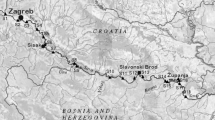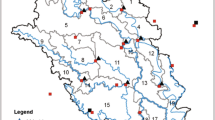Abstract
To evaluate the significant sources contributing to water quality parameters, we used principal component analysis (PCA) for the interpretation of a large complex data matrix obtained from the Kandla creek environmental monitoring program. The data set consists of analytical results of a seasonal sampling survey conducted over 2 years at four stations. PCA indicates five principal components to be responsible for the data structure and explains 76% of the total variance of the data set. The study stresses the need to include new parameters in the analysis in order to make the interpretation of principal components more meaningful. The PCA could be applied as a useful tool to eliminate multi-collinearity problems and to remove the indirect effect of parameters.
Similar content being viewed by others
References
APHA (1975). Standard methods for the examination of water and waste water (14th ed.). APHA-AWWA-WPCE, American Public Health, Washington DC20036.
Bengraine, K., & Marhaba, T. F. (2003). Using principal component analysis to monitor spatial and temporal changes in water quality. Journal of Hazardous Materials, B100, 179–195. doi:10.1016/S0304-3894(03)00104-3.
EGPH (1989). Environmental guidelines for ports and harbour projects. New Delhi: Govt. of India.
Grasshoff, K., Ehrhardt, M., & Krimling, K. (1983). Methods of seawater analyses (Second revised and extended edition, 419 pp.). Weinheim: Verlag Chemie.
Grossman, G. D., Nicckerso, D. M., & Freeman, M. C. (1991). Principal component analyses of assemblages structure data: Utility of tests based on eigenvalues. Ecology, 72(1), 341–347. doi:10.2307/1938927.
Helena, B., Pardo, R., Vega, M., Barrado, E., Fernandez, J. M., & Fernandez, L. (2000). Temporal evolution of groundwater composition in an alluvial aquifer (Pisuerga River, Spain) by principal component analysis. Water Research, 34, 807–816. doi:10.1016/S0043-1354(99)00225-0.
Jackson, D. A. (1993). Stopping rules in principal components analysis: A comparison of heuristical and statistical approaches. Ecology, 74, 2201–2214.
Kennish, M. J. (1992). Ecology of estuaries: Anthropogenic effects (494 pp.). Florida: CRC.
Morales, M. M., Mart, P., Llopis, A., Campos, L., & Sagrado, J. (1999). An environmental study by factor analysis of surface seawater in the Gulf of Valencia (western Mediterranean). Analytica Chimica Acta, 394, 109–117. doi:10.1016/S0003-2670(99)00198-1.
Petersen, W., Bertino, L., Callies, U., & Zorita, E. (2001). Process identification by principal component analysis of river water-quality data. Ecological Modelling, 138, 193–213. doi:10.1016/S0304-3800(00)00402-6.
Ross, P. J. (1988). Taguchi techniques for quality engineering. New York: McGraw-Hill.
Schramm, W., & Nienhuis, P. H. (1996). Marine benthic vegetation: Recent changes and the effects of eutrophication (470 pp.). Berlin: Springer.
Simeonov, V., Stratis, J. A., Samara, C., Zachariadis, G., Voutsa, D., Anthemidis, A., et al. (2003). Assessment of the surface water quality in Northern Greece. Water Research, 37, 4119–4124. doi:10.1016/S0043-1354(03)00398-1.
Singh, K. P., Malik, A., Mohan, D., & Sinha, S. (2004). Multivariate statistical techniques for the evaluation of spatial and temporal variations in water quality of Gomti River (India): A case study. Water Research, 38, 3980–3992. doi:10.1016/j.watres.2004.06.011.
Stevens, J. (1986). Applied multivariate statistics for the social science (515 pp.). Hillsdale: Erlbaum.
Vega, M., Pardo, R., Barrado, E., & Deban, L. (1998). Assessment of seasonal and polluting effects on the quality of river water by exploratory data analysis. Water Research, 32, 3581–3592. doi:10.1016/S0043-1354(98)00138-9.
Williams, K. K., & Titus, K. (1988). Assessment and sampling stability in ecological applications of discriminate analysis. Ecology, 69(4), 1275–1285. doi:10.2307/1941283.
Wunderlin, D. A., Diaz, M. P., Ame, M. V., Pesce, S. F., Hued, A. C., & Bistoni, M. (2001). Pattern recognition techniques for the evaluation of spatial and temporal variation in water quality. A case study: Suquia river basin (Cordoba Argentina). Water Research, 35, 2881–2894. doi:10.1016/S0043-1354(00)00592-3.
Author information
Authors and Affiliations
Corresponding author
Rights and permissions
About this article
Cite this article
Dalal, S.G., Shirodkar, P.V., Jagtap, T.G. et al. Evaluation of significant sources influencing the variation of water quality of Kandla creek, Gulf of Katchchh, using PCA. Environ Monit Assess 163, 49–56 (2010). https://doi.org/10.1007/s10661-009-0815-y
Received:
Accepted:
Published:
Issue Date:
DOI: https://doi.org/10.1007/s10661-009-0815-y




